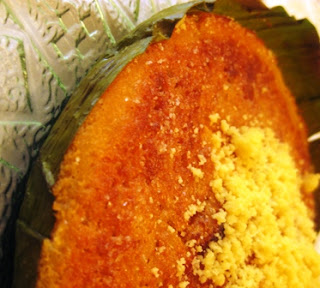==========================================================================
SUMAN

Sweet basics: A rice cake made from glutinous rice and usually wrapped tightly in leaves. Sta. Maria notes that the leaf wrapper—banana, palm, buri and pandan—varies according to locality. Some can be bought in bunches or in single portions.
Origin: Filipinos have been making the suman since pre-colonial times. We offer it to the gods and as presents to visitors. Antonio Pigafetta, according to Sta. Maria, provides the first description of the rice cakes, which he observed “were wrapped in leaves and were made in somewhat longish pieces.”
Interesting layers: Almost all provinces have their own special suman. There’s suman sa ibos, suman sa lihia, sumang balinghoy, sumang inantala, sumang mais, sumang maruecos, sumang saba, suman sa budbud. From Pampanga there’s suman a duman, suman a inangit, suman a patupat. From Dumaguete, the budbud kabug is made from millet instead of rice. In Leyte, there’s suman nga matamis, suman inasin, tinipa, morón, sagmani and binagol.
SUMAN

Sweet basics: A rice cake made from glutinous rice and usually wrapped tightly in leaves. Sta. Maria notes that the leaf wrapper—banana, palm, buri and pandan—varies according to locality. Some can be bought in bunches or in single portions.
Origin: Filipinos have been making the suman since pre-colonial times. We offer it to the gods and as presents to visitors. Antonio Pigafetta, according to Sta. Maria, provides the first description of the rice cakes, which he observed “were wrapped in leaves and were made in somewhat longish pieces.”
Interesting layers: Almost all provinces have their own special suman. There’s suman sa ibos, suman sa lihia, sumang balinghoy, sumang inantala, sumang mais, sumang maruecos, sumang saba, suman sa budbud. From Pampanga there’s suman a duman, suman a inangit, suman a patupat. From Dumaguete, the budbud kabug is made from millet instead of rice. In Leyte, there’s suman nga matamis, suman inasin, tinipa, morón, sagmani and binagol.
 Traditional Bibingka Lipa (dense, sweet and wet version)
Traditional Bibingka Lipa (dense, sweet and wet version) 2 ½ cups rice flour (plain)
2 tbsp baking powder
1 – 1 ½ cups sugar
1 cup milk
1 ½ cups coconut milk
½ cup melted margarine
5-6 large eggs
4 Salted Egg/ itlog na pula, sliced
1 cup grated Edam cheese
In a bowl, combine all the ingredients except salted eggs and edam cheese. Stir the mixture until smooth then refrigerate for 1-2 hours.
Pour in buttered pans lined with banana leaves then sprinkle top with salted eggs Bake at 375 oven until golden. Remove from the oven then sprinkle 2 tbsp sugar on top then broil for 2-3 minutes until top is browned. Sprinkle with edam cheese.
To make the cafe barako: Combine in a pot ½ cup ground coffee and 3-4 cups water. Bring to a boil, strain through a fine sieve lined with coffee paper or paper towel. Serve with muscovado brown sugar and milk.
=========================================================================
Patupat- a special kakanin/ delicacy of Pangasinan that looks like native purse made of palm leaves . Inside is a very sticky rice kakanin similar to “kalamay”. Messy to eat but worth in every bite.
========================================================================
BIKO
Sweet basics: Biko is a kakanin topped with latik (the golden brown curdles that form after rendering oil from coconut cream). It’s usually made by cooking glutinous rice (sinaing) then boiling it in coconut milk and panocha (or sugar) until dry. Some recipes add pirurutong for color. The biko is cooled in a pan then sliced.
Origins: This rice cake is Chinese in origin.
Interesting layers: Some biko are flavored with anise, ginger or calamansi rind. The shade of the biko depends on the sugar used—white sugar or light brown for a lighter biko, darker sugar for a darker biko.
==========================================================================
SAPIN-SAPIN

Sweet basics: Sapin-sapin is a colorful layered rice cake, made from glutinous rice flour, coconut milk and sugar. The best sapin-sapin is the one with a texture so fine it glides and tastes milky. Its colors—violet, yellow and white—makes it more attractive. Latik is sprinkled on the top. Also served with grated coconut.
Origin: From the root word sapin which is Tagalog for “blanket,” the name pertains to the layers of rice cake. The best sapin-sapin I’ve tasted was freshly made from the pamilihang bayan of Malabon, also home to many rice cake makers. Gilda Cordero Fernando notes that the best sapin-sapin is claimed by all Central Luzon provinces, one of which is Nueva Ecija. She says their version is six or seven-layered, creamy, and melt in your mouth.
Interesting layers: To achieve the blankets of kakanin, each layer is steamed until set before the next layer is added. Before the advent of food coloring, Sta. Maria notes the traditional colors were purple (ube), golden brown (brown sugar), and white (white sugar). Some sapin-sapin are sold as several small rectangles of one color each formed in concentric circles.
==========================================================================
KUTSINTA

Sweet basics: Kutsinta or cuchinta is a steamed rice cake made from ground rice, sugar and lye. The latter, according to Fernandez, gives kutsinta its light brown (almost muddy orange) color as well as its opaque, “jelly-like texture.”
Sta. Maria refers to it as “a steamed rice pudding.” Kutsinta is usually sold in packs and served with grated coconut. Modern kutsinta are served thickly sliced and topped with latik and langka.
Origin: The ingredients are same as suman and puto so it must exist alongside these rice cakes though it could be a later concoction. However, the etymology of the word remains sticky. The word and spelling is mysteriously missing from my trusty first edition UP Diksiyonaryong Filipino.
Interesting layers: To get its characteristic round shape (like a tiny plato), kutsinta can be steamed on a muffin pan placed inside a steamer. In 1940, Kapampangans used su-it or “small Chinese porcelain wine cups” to mold the kutsinta, writes Sta. Maria.










